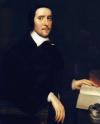Biography
Jeremy Taylor (1613 - 13 August 1667) was a clergyman in the Church of England who achieved fame as an author during the Protectorate of Oliver Cromwell. He is sometimes known as the "Shakespeare of Divines" for his poetic style of expression and was often presented as a model of prose writing. He is remembered in the Church of England's calendar of saints with a Lesser Festival on 13 August.
Taylor was educated at the Perse School, Cambridge before going on to Gonville and Caius College, at Cambridge, where he graduated in 1626.[1] He was under the patronage of William Laud, Archbishop of Canterbury. He went on to become chaplain in ordinary to King Charles I as a result of Laud's sponsorship. This made him politically suspect when Laud was tried for treason and executed in 1645 by the Puritan Parliament during the English Civil War. After the Parliamentary victory over the King, he was briefly imprisoned several times.
Eventually, he was allowed to live quietly in Wales, where he became the private chaplain of the Earl of Carbery. At the Restoration, his political star was on the rise, and he was made Bishop of Down and Connor in Ireland. He also became vice-chancellor of the University of Dublin.
Archbishop William Laud sent for Taylor to preach in his presence at Lambeth, and took the young man under his wing. Taylor did not vacate his fellowship at Cambridge before 1636, but he spent, apparently, much of his time in London, for Laud desired that his considerable talents should receive better opportunities of study and improvement than the obligations of constant preaching would permit. In November 1635 he had been nominated by Laud to a fellowship at All Souls, Oxford, where, says Wood (Athen. Oxon., Ed. Bliss, iii. 781), love and admiration still waited on him. He seems, however, to have spent little time there. He became chaplain to his patron the archbishop, and chaplain in ordinary to Charles I. At Oxford, William Chillingworth was then busy with his magnum opus, The Religion of Protestants, and it is possible that through discussion with Chillingworth Taylor may have been turned towards the liberal movement of his age. After two years in Oxford, he was presented, in March 1638, by William Juxon, bishop of London, to the rectory of Uppingham, in Rutland.
In the next year he married Phoebe Langsdale, by whom he had six children, the eldest of whom died at Uppingham in 1642. In the autumn of the same year he was appointed to preach in St Marys on the anniversary of the Gunpowder Plot, and apparently used the occasion to clear himself of a suspicion, which, however, haunted him through life, of a secret leaning to the Roman Catholic position. This suspicion seems to have arisen chiefly from his intimacy with Christopher Davenport, better known as Francis a Sancta Clara, a learned Franciscan friar who became chaplain to Queen Henrietta; but it may have been strengthened by his known connection with Laud, as well as by his ascetic habits. More serious consequences followed his attachment to the Royalist cause. The author of The Sacred Order and Offices of Episcopacy or Episcopacy Asserted against the Arians and Acephali New and Old (1642), could scarcely hope to retain his parish, which was not, however, sequestrated until 1644. Taylor probably accompanied the king to Oxford. In 1643 he was presented to the rectory of Overstone, Northamptonshire, by Charles I. There he would be in close connection with his friend and patron Spencer Compton, 2nd earl of Northampton.
During the next fifteen years Taylor's movements are not easily traced. He seems to have been in London during the last weeks of Charles I in 1649, from whom he is said to have received his watch and some jewels which had ornamented the ebony case in which he kept his Bible. He had been taken prisoner with other Royalists while besieging Cardigan Castle on 4 February 1645. In 1646 he is found in partnership with two other deprived clergymen, keeping a school at Newton Hall, in the parish of Llanfihangel-Aberbythych, Carmarthenshire. Here he became private chaplain to and benefited from the hospitality of Richard Vaughan, 2nd earl of Carbery, whose mansion, Golden Grove, is immortalized in the title of Taylor's still popular manual of devotion, and whose first wife was a constant friend of Taylor. The second Lady Carbery was the original of the Lady in John Milton's Comus. Taylor's first wife had died early in 1651. He second wife was Joanna Bridges, a natural daughter of Charles I. She owned a good estate, though probably impoverished by Parliamentarian exactions, at Mandinam, in Carmarthenshire. Several years following their marriage, they moved to Ireland. Two daughters were born to them.
From time to time Jeremy Taylor appears in London in the company of his friend Evelyn, in whose diary and correspondence his name repeatedly occurs. He was imprisoned three times: in 1645 for an injudicious preface to his Golden Grove; again in Chepstow castle, from May to October 1655, on what charge does not appear; and a third time in the Tower in 1657, because of the indiscretion of his publisher, Richard Royston, who had decorated his Collection of Offices with a print representing Christ in the attitude of prayer. ..






